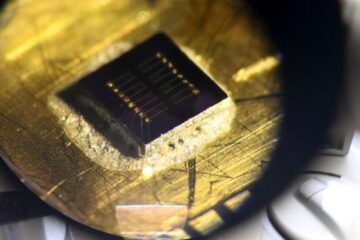An Inexpensive “Dipstick” Test for Pesticides in Foods

The study is in the November 1 issue of ACS’ Analytical Chemistry, a semi-monthly journal. John Brennan and colleagues note in the new study that conventional tests for detecting pesticides tend to use expensive and complex equipment and in some cases can take several hours to produce results. They cite a growing need for cheaper, more convenient, and more eco-friendly tests for pesticides, particularly in the food industry.
The scientists describe the development of a new paper-based test strip that changes color shades depending on the amount of pesticide present. In laboratory studies using food and beverage samples intentionally contaminated with common pesticides, the test strips accurately identified minute amounts of pesticides. The test strips, which produced results in less than 5 minutes, could be particularly useful in developing countries or remote areas that may lack access to expensive testing equipment and electricity, they note.
ARTICLE FOR IMMEDIATE RELEASE
“Reagentless Bidirectional Lateral Flow Bioactive Paper Sensors for Detection of Pesticides in Beverage and Food Samples”
DOWNLOAD FULL TEXT ARTICLE :
http://pubs.acs.org/stoken/presspac/presspac/full/10.1021/ac901714h
Science Inquiries: Michael Woods, editor
m_woods@acs.org
202-872-6293
General Inquiries: Michael Bernstein
m_bernstein@acs.org
202-872-6042
Media Contact
More Information:
http://www.acs.orgAll latest news from the category: Health and Medicine
This subject area encompasses research and studies in the field of human medicine.
Among the wide-ranging list of topics covered here are anesthesiology, anatomy, surgery, human genetics, hygiene and environmental medicine, internal medicine, neurology, pharmacology, physiology, urology and dental medicine.
Newest articles

Sea slugs inspire highly stretchable biomedical sensor
USC Viterbi School of Engineering researcher Hangbo Zhao presents findings on highly stretchable and customizable microneedles for application in fields including neuroscience, tissue engineering, and wearable bioelectronics. The revolution in…

Twisting and binding matter waves with photons in a cavity
Precisely measuring the energy states of individual atoms has been a historical challenge for physicists due to atomic recoil. When an atom interacts with a photon, the atom “recoils” in…

Nanotubes, nanoparticles, and antibodies detect tiny amounts of fentanyl
New sensor is six orders of magnitude more sensitive than the next best thing. A research team at Pitt led by Alexander Star, a chemistry professor in the Kenneth P. Dietrich…





















